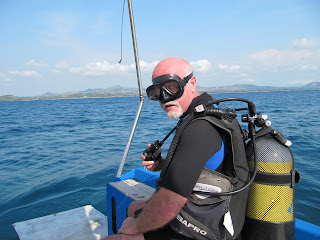 |
| Amanda on the Great Barrier Reef |
 |
| Diving off Madagascar |
I have extolled the virtues of Falmouth and Cornwall many times on this blog, the wonderful walks, mining heritage, gardens, restaurants etc, and have never mentioned its rich underwater attractions, which I am sure will be of interest to many of our summer MEI Conference delegates.
I gave up serious diving in 1979, having logged around 200 dives along the whole of the south Cornwall coast, from Land’s End to the Eddystone Lighthouse near Plymouth. I had qualified as a diver in 1969, with the British Sub-Aqua Club (BSAC), training in freezing reservoirs in the north of England, but most of my dives were from 1975, when I formed the Camborne School of Mines branch of BSAC, and then later became Diving Officer for the Falmouth Branch. Looking back it is strange that not one of my dives was on the rugged North Cornwall coast, partly because to get there would have meant a very long sea journey around Land’s End, but also because the south coast has one very great attraction- a profusion of ship-wrecks. This coast is the entry into the English Channel, always one of the world’s busiest seaways, with treacherous rocks and reefs, and sometimes local inhabitants, inviting the unwary to their doom. Indeed stories of the Cornish ‘wreckers’ are legendary. Daphne du Maurier’s famous book ‘Jamaica Inn’ is a classic tale of a band of wreckers, who set up false lights to lure ships onto rocks so that their contents can be looted.
 |
| A dolphin joins us off Pendennis Point, Falmouth |
 |
| Souvenirs from the Mohegan |
Well over a hundred ships have been wrecked and nearly a thousand people drowned on the Manacles, which stretch almost a mile out to sea, with depths ranging from 12m to 62m. The attraction for divers is not just the wrecks, however, as the deep granite gulleys, covered with anenomes and gorgonia coral, teem with life, including the colourful cuckoo wrasse, pollack and the elusive bass. If you are lucky you may also encounter the massive, but benign, basking sharks which are frequent summer visitors to the coast.
‘Modern’ divers may be interested in this picture, taken in 1976, at the Manacles. In those fairly early days of amateur diving we wore wetsuits, which provided inadequate protection from the cold, as the bubbles in the neoprene compressed with depth, greatly reducing their insulating properties. The modern dry suit started to appear in the late ‘70s, but many divers were initially wary of them and continued to wear their wetsuits underneath, as added security. Although we often dived to depths of over 50 metres, compressed air was always used to fill our bottles, allowing us only short dive times and long decompression stops. Nowadays amateur divers use gas mixtures, such as “nitrox”, which contain reduced amounts of nitrogen, reducing the risk of ‘the bends’ and nitrogen narcosis. I am in the right of the picture, and the large device on my right wrist is one of the earliest, and not very reliable, decompression computers, which are today incorporated with the depth gauge in the diver’s wristwatch!
If you are attending an MEI Conference in Falmouth, and would like to experience the diving, I would suggest that you contact Cornwall Divers, who can arrange dives for you and rent the necessary equipment.



















.jpg)

I'm afraid that I'm going to have to disagree with you here... my experience of diving the Great Barrier Reef (and also the Ningaloo Reef in Western Australia) was one of the most amazing of my life.
ReplyDeleteLeaving aside the fact that it was pure pleasure to be able to dive in such warm water, the sheer variety and number of species to be found on both reefs was breathtaking; it is estimated that 25% of all marine species live on coral reefs. I vividly remember entering the water on my first reef dive and spinning round and around trying to take in the magnificent sight before me - and spinning right into some coral which proceeded to attack me!
I can't imagine ever getting bored of reef diving, there's just too much going on. From the infamous clown fish darting unharmed amongst the anemones, to the parrot fish nibbling away at the coral, to the moray eels hiding in deep coral crevices, to the reef sharks cruising around as though they own the place - it's just all going on!
Thought you might disagree with me!! It's only a personal thing, and yes I do agree that reef diving has great attractions, but for me diving was all about wrecks- researching them, locating them and then diving on them.
DeleteWarm water is great I know, but I did have my own method of introducing warm water to my wetsuit!
Your method doesn't really help with the ice-cream head/brain freeze though does it? Unless.... no! don't go there :)
ReplyDeleteYes it does help. I was, of course, referring to pouring a thermos flask of warm water into the wetsuit- or hood!
DeleteI'm not gonna say if I disagree or agree with what you said. Each divers have their own preferences when it comes to diving spots.For me, I enjoy both diving in the tropical and cold waters. Each has its own attraction. What I love about Cornwall are its wrecks but aside from that I also love the deep granite gulleys and the basking sharks! :)
ReplyDelete